NURSING 14: Exploring the Gendered Nature of Nursing Profession
VerifiedAdded on 2022/11/25
|15
|4363
|72
Discussion Board Post
AI Summary
This discussion paper delves into the gendered nature of nursing, examining the historical context, current challenges, and potential solutions to foster a more balanced and inclusive healthcare environment. The paper begins by defining nursing and its association with female virtues, then proceeds to explore the benefits and challenges associated with the presence of male nurses in the profession. It highlights how societal stereotypes and gender roles have shaped the nursing landscape, leading to a disproportionate representation of males in the field. The paper also discusses the impact of this imbalance on patient care, including the preferences of patients, the potential for burnout among male nurses, and the overall shortage of nursing professionals. The author provides recommendations for addressing the gendered nature of nursing, emphasizing the importance of creating a more inclusive environment that attracts and retains both male and female nurses to improve patient care. The paper references numerous scholarly articles to support its arguments and adheres to APA format guidelines.
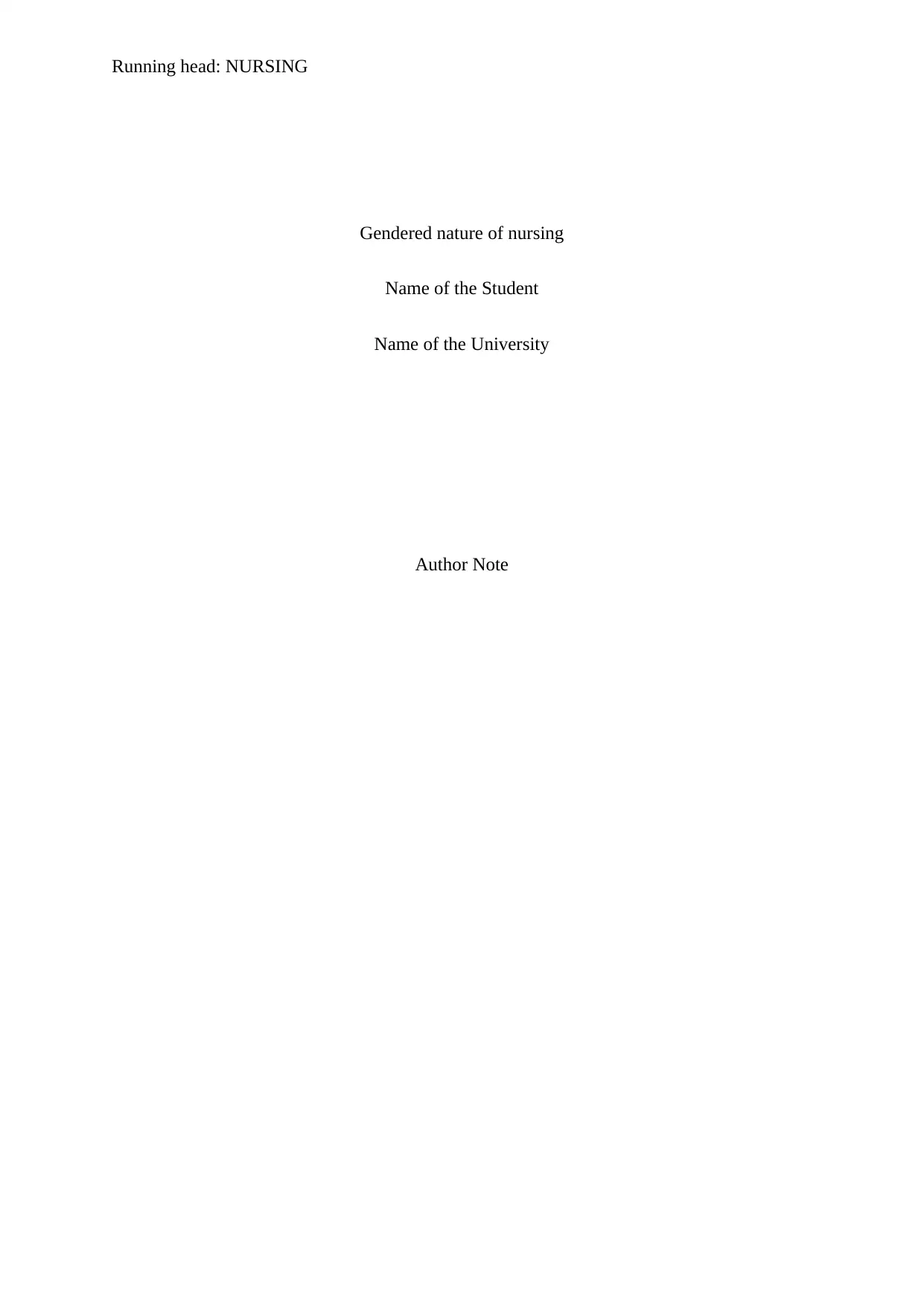
Running head: NURSING
Gendered nature of nursing
Name of the Student
Name of the University
Author Note
Gendered nature of nursing
Name of the Student
Name of the University
Author Note
Paraphrase This Document
Need a fresh take? Get an instant paraphrase of this document with our AI Paraphraser
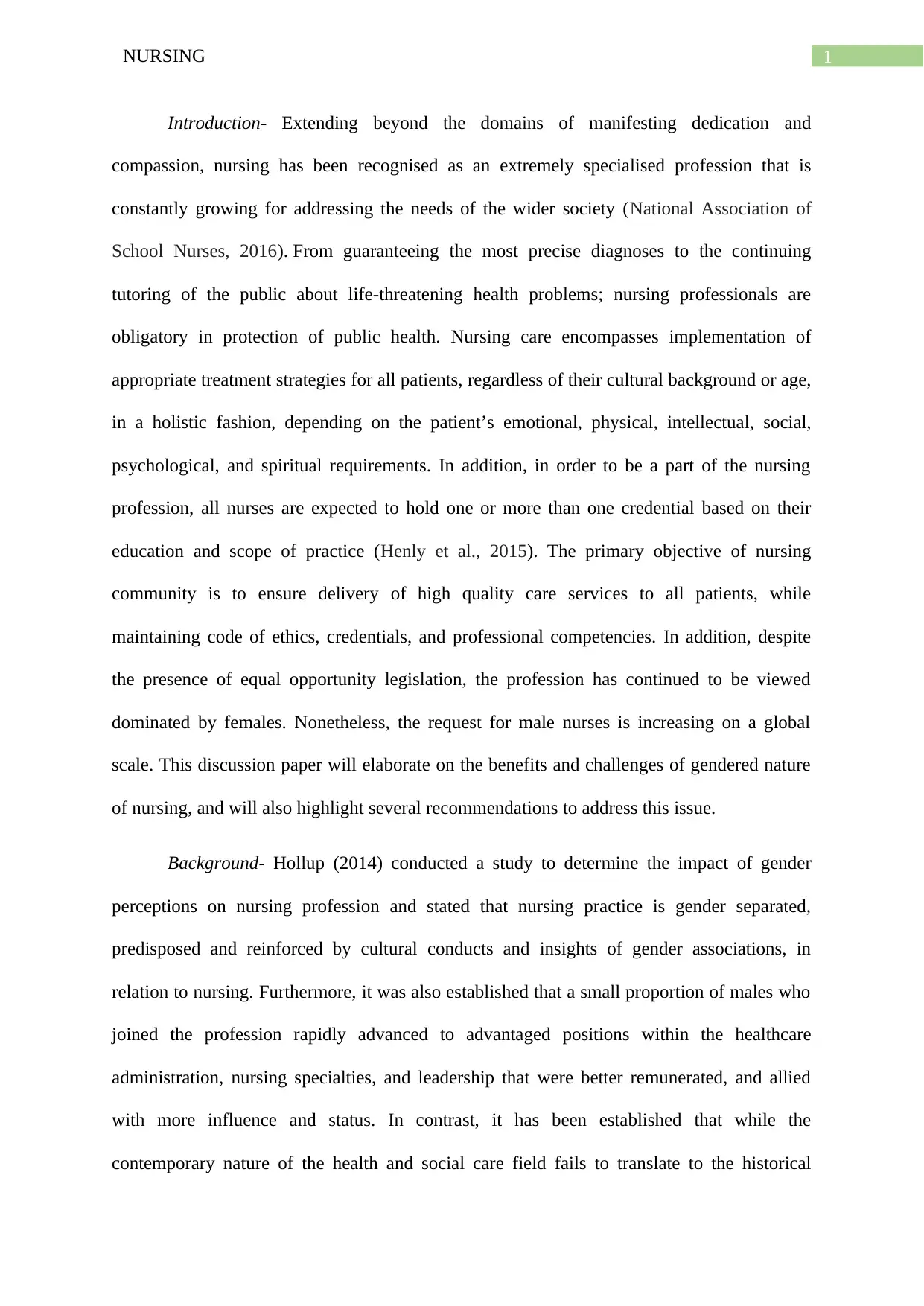
1NURSING
Introduction- Extending beyond the domains of manifesting dedication and
compassion, nursing has been recognised as an extremely specialised profession that is
constantly growing for addressing the needs of the wider society (National Association of
School Nurses, 2016). From guaranteeing the most precise diagnoses to the continuing
tutoring of the public about life-threatening health problems; nursing professionals are
obligatory in protection of public health. Nursing care encompasses implementation of
appropriate treatment strategies for all patients, regardless of their cultural background or age,
in a holistic fashion, depending on the patient’s emotional, physical, intellectual, social,
psychological, and spiritual requirements. In addition, in order to be a part of the nursing
profession, all nurses are expected to hold one or more than one credential based on their
education and scope of practice (Henly et al., 2015). The primary objective of nursing
community is to ensure delivery of high quality care services to all patients, while
maintaining code of ethics, credentials, and professional competencies. In addition, despite
the presence of equal opportunity legislation, the profession has continued to be viewed
dominated by females. Nonetheless, the request for male nurses is increasing on a global
scale. This discussion paper will elaborate on the benefits and challenges of gendered nature
of nursing, and will also highlight several recommendations to address this issue.
Background- Hollup (2014) conducted a study to determine the impact of gender
perceptions on nursing profession and stated that nursing practice is gender separated,
predisposed and reinforced by cultural conducts and insights of gender associations, in
relation to nursing. Furthermore, it was also established that a small proportion of males who
joined the profession rapidly advanced to advantaged positions within the healthcare
administration, nursing specialties, and leadership that were better remunerated, and allied
with more influence and status. In contrast, it has been established that while the
contemporary nature of the health and social care field fails to translate to the historical
Introduction- Extending beyond the domains of manifesting dedication and
compassion, nursing has been recognised as an extremely specialised profession that is
constantly growing for addressing the needs of the wider society (National Association of
School Nurses, 2016). From guaranteeing the most precise diagnoses to the continuing
tutoring of the public about life-threatening health problems; nursing professionals are
obligatory in protection of public health. Nursing care encompasses implementation of
appropriate treatment strategies for all patients, regardless of their cultural background or age,
in a holistic fashion, depending on the patient’s emotional, physical, intellectual, social,
psychological, and spiritual requirements. In addition, in order to be a part of the nursing
profession, all nurses are expected to hold one or more than one credential based on their
education and scope of practice (Henly et al., 2015). The primary objective of nursing
community is to ensure delivery of high quality care services to all patients, while
maintaining code of ethics, credentials, and professional competencies. In addition, despite
the presence of equal opportunity legislation, the profession has continued to be viewed
dominated by females. Nonetheless, the request for male nurses is increasing on a global
scale. This discussion paper will elaborate on the benefits and challenges of gendered nature
of nursing, and will also highlight several recommendations to address this issue.
Background- Hollup (2014) conducted a study to determine the impact of gender
perceptions on nursing profession and stated that nursing practice is gender separated,
predisposed and reinforced by cultural conducts and insights of gender associations, in
relation to nursing. Furthermore, it was also established that a small proportion of males who
joined the profession rapidly advanced to advantaged positions within the healthcare
administration, nursing specialties, and leadership that were better remunerated, and allied
with more influence and status. In contrast, it has been established that while the
contemporary nature of the health and social care field fails to translate to the historical
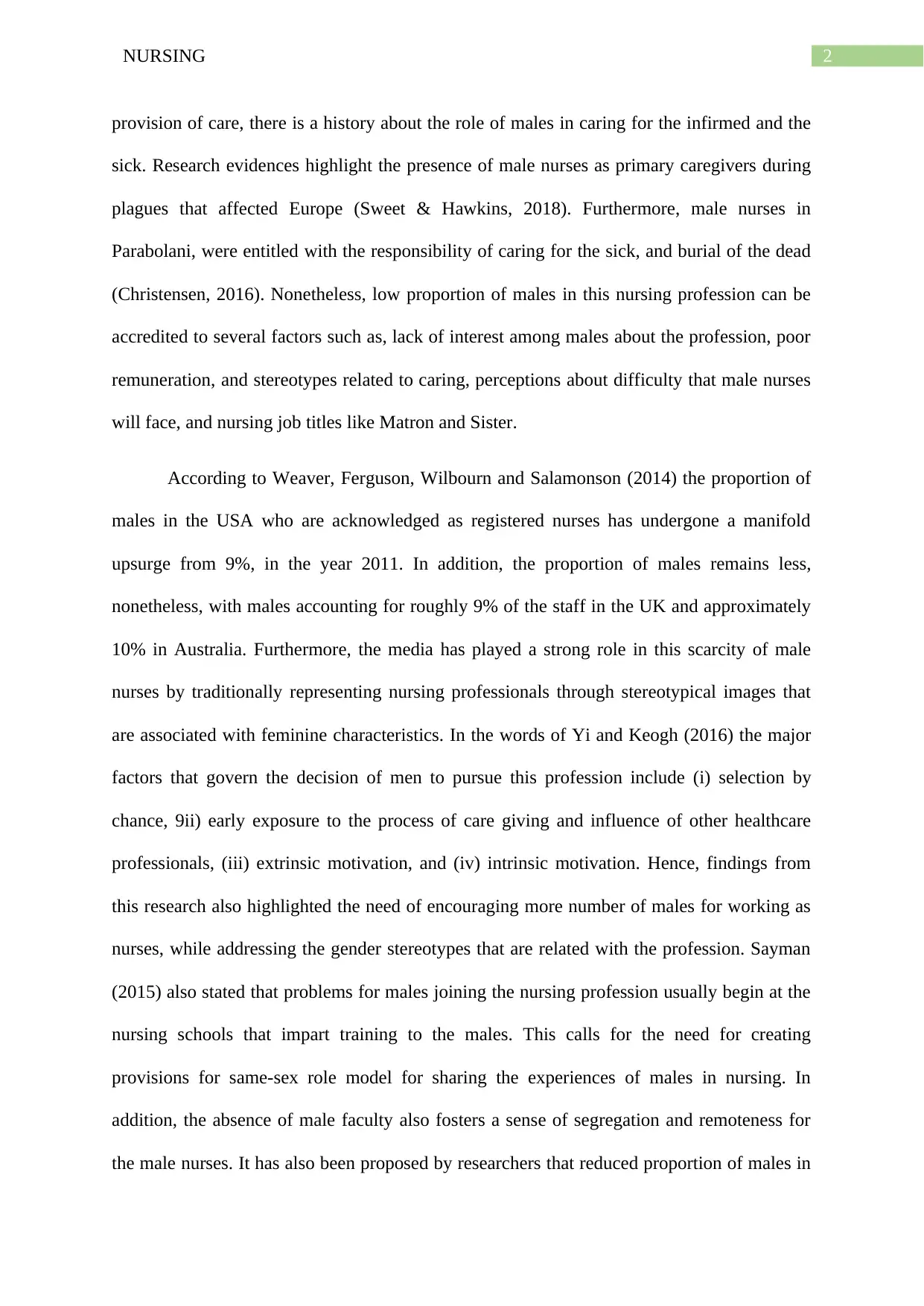
2NURSING
provision of care, there is a history about the role of males in caring for the infirmed and the
sick. Research evidences highlight the presence of male nurses as primary caregivers during
plagues that affected Europe (Sweet & Hawkins, 2018). Furthermore, male nurses in
Parabolani, were entitled with the responsibility of caring for the sick, and burial of the dead
(Christensen, 2016). Nonetheless, low proportion of males in this nursing profession can be
accredited to several factors such as, lack of interest among males about the profession, poor
remuneration, and stereotypes related to caring, perceptions about difficulty that male nurses
will face, and nursing job titles like Matron and Sister.
According to Weaver, Ferguson, Wilbourn and Salamonson (2014) the proportion of
males in the USA who are acknowledged as registered nurses has undergone a manifold
upsurge from 9%, in the year 2011. In addition, the proportion of males remains less,
nonetheless, with males accounting for roughly 9% of the staff in the UK and approximately
10% in Australia. Furthermore, the media has played a strong role in this scarcity of male
nurses by traditionally representing nursing professionals through stereotypical images that
are associated with feminine characteristics. In the words of Yi and Keogh (2016) the major
factors that govern the decision of men to pursue this profession include (i) selection by
chance, 9ii) early exposure to the process of care giving and influence of other healthcare
professionals, (iii) extrinsic motivation, and (iv) intrinsic motivation. Hence, findings from
this research also highlighted the need of encouraging more number of males for working as
nurses, while addressing the gender stereotypes that are related with the profession. Sayman
(2015) also stated that problems for males joining the nursing profession usually begin at the
nursing schools that impart training to the males. This calls for the need for creating
provisions for same-sex role model for sharing the experiences of males in nursing. In
addition, the absence of male faculty also fosters a sense of segregation and remoteness for
the male nurses. It has also been proposed by researchers that reduced proportion of males in
provision of care, there is a history about the role of males in caring for the infirmed and the
sick. Research evidences highlight the presence of male nurses as primary caregivers during
plagues that affected Europe (Sweet & Hawkins, 2018). Furthermore, male nurses in
Parabolani, were entitled with the responsibility of caring for the sick, and burial of the dead
(Christensen, 2016). Nonetheless, low proportion of males in this nursing profession can be
accredited to several factors such as, lack of interest among males about the profession, poor
remuneration, and stereotypes related to caring, perceptions about difficulty that male nurses
will face, and nursing job titles like Matron and Sister.
According to Weaver, Ferguson, Wilbourn and Salamonson (2014) the proportion of
males in the USA who are acknowledged as registered nurses has undergone a manifold
upsurge from 9%, in the year 2011. In addition, the proportion of males remains less,
nonetheless, with males accounting for roughly 9% of the staff in the UK and approximately
10% in Australia. Furthermore, the media has played a strong role in this scarcity of male
nurses by traditionally representing nursing professionals through stereotypical images that
are associated with feminine characteristics. In the words of Yi and Keogh (2016) the major
factors that govern the decision of men to pursue this profession include (i) selection by
chance, 9ii) early exposure to the process of care giving and influence of other healthcare
professionals, (iii) extrinsic motivation, and (iv) intrinsic motivation. Hence, findings from
this research also highlighted the need of encouraging more number of males for working as
nurses, while addressing the gender stereotypes that are related with the profession. Sayman
(2015) also stated that problems for males joining the nursing profession usually begin at the
nursing schools that impart training to the males. This calls for the need for creating
provisions for same-sex role model for sharing the experiences of males in nursing. In
addition, the absence of male faculty also fosters a sense of segregation and remoteness for
the male nurses. It has also been proposed by researchers that reduced proportion of males in
⊘ This is a preview!⊘
Do you want full access?
Subscribe today to unlock all pages.

Trusted by 1+ million students worldwide

3NURSING
nursing is not a concern outside the US owing to the fact that an estimated 35% of the
military comprises of male nurses, when compared to the civilian population. Moreover, the
unprecedented excess of male nursing professionals in Jordan has eventually resulted in 30%
restriction of admission of males in different nursing schools. The findings also highlighted
that the percentage of male nursing staff in several countries ranged from as low as 9% in
New Zealand to 38% in Jordan, thus highlighting on the gendered nature of nursing (Carrigan
& Brooks, 2016).
Definition and scope- The profession of nursing has long been associated with several
female virtues that encompass nurturance, compassion, care and altruism. In addition, it has
often been described in gendered terms such as, mission of females, humanitarian service,
and ministry, besides describing the profession as a service of conscience and womanly duty
(McIntyre & McDonald, 2013). The issue is of significance in relation to Canadian health
workforce since data from 2018 suggests that there were an estimated 389,648 female and
37,636 male nurses in Canada, with male nurses accounting for 9.5% of the total population
(Canada Nurses Association, 2018). Furthermore, male nurses also accounted for a 32% rise
in the number of regulated nursing staff in Canada. Hence, it can be suggested that shortage
of male nurses has created a significant impact throughout Canada. It has been elaborated by
Sedgwick and Kellett (2015) that hostile recruitment approaches used in the undergraduate
nursing programs prevalent in Canada have been subjected to modest success, owing to the
fact that male nursing students embody a small fraction of the entire undergraduate
population. The researchers suggested that most male nurses in Canada report feelings of
discrimination and marginalisation, despite the identical benefits and starting salaries that
significantly contribute to the less percentage of men in nursing profession.
According to Twomey and Meadus (2016) the healthcare industry is subjected to a
shortage of workforce all across the nation and in Canada, not more than 7% of the nursing
nursing is not a concern outside the US owing to the fact that an estimated 35% of the
military comprises of male nurses, when compared to the civilian population. Moreover, the
unprecedented excess of male nursing professionals in Jordan has eventually resulted in 30%
restriction of admission of males in different nursing schools. The findings also highlighted
that the percentage of male nursing staff in several countries ranged from as low as 9% in
New Zealand to 38% in Jordan, thus highlighting on the gendered nature of nursing (Carrigan
& Brooks, 2016).
Definition and scope- The profession of nursing has long been associated with several
female virtues that encompass nurturance, compassion, care and altruism. In addition, it has
often been described in gendered terms such as, mission of females, humanitarian service,
and ministry, besides describing the profession as a service of conscience and womanly duty
(McIntyre & McDonald, 2013). The issue is of significance in relation to Canadian health
workforce since data from 2018 suggests that there were an estimated 389,648 female and
37,636 male nurses in Canada, with male nurses accounting for 9.5% of the total population
(Canada Nurses Association, 2018). Furthermore, male nurses also accounted for a 32% rise
in the number of regulated nursing staff in Canada. Hence, it can be suggested that shortage
of male nurses has created a significant impact throughout Canada. It has been elaborated by
Sedgwick and Kellett (2015) that hostile recruitment approaches used in the undergraduate
nursing programs prevalent in Canada have been subjected to modest success, owing to the
fact that male nursing students embody a small fraction of the entire undergraduate
population. The researchers suggested that most male nurses in Canada report feelings of
discrimination and marginalisation, despite the identical benefits and starting salaries that
significantly contribute to the less percentage of men in nursing profession.
According to Twomey and Meadus (2016) the healthcare industry is subjected to a
shortage of workforce all across the nation and in Canada, not more than 7% of the nursing
Paraphrase This Document
Need a fresh take? Get an instant paraphrase of this document with our AI Paraphraser
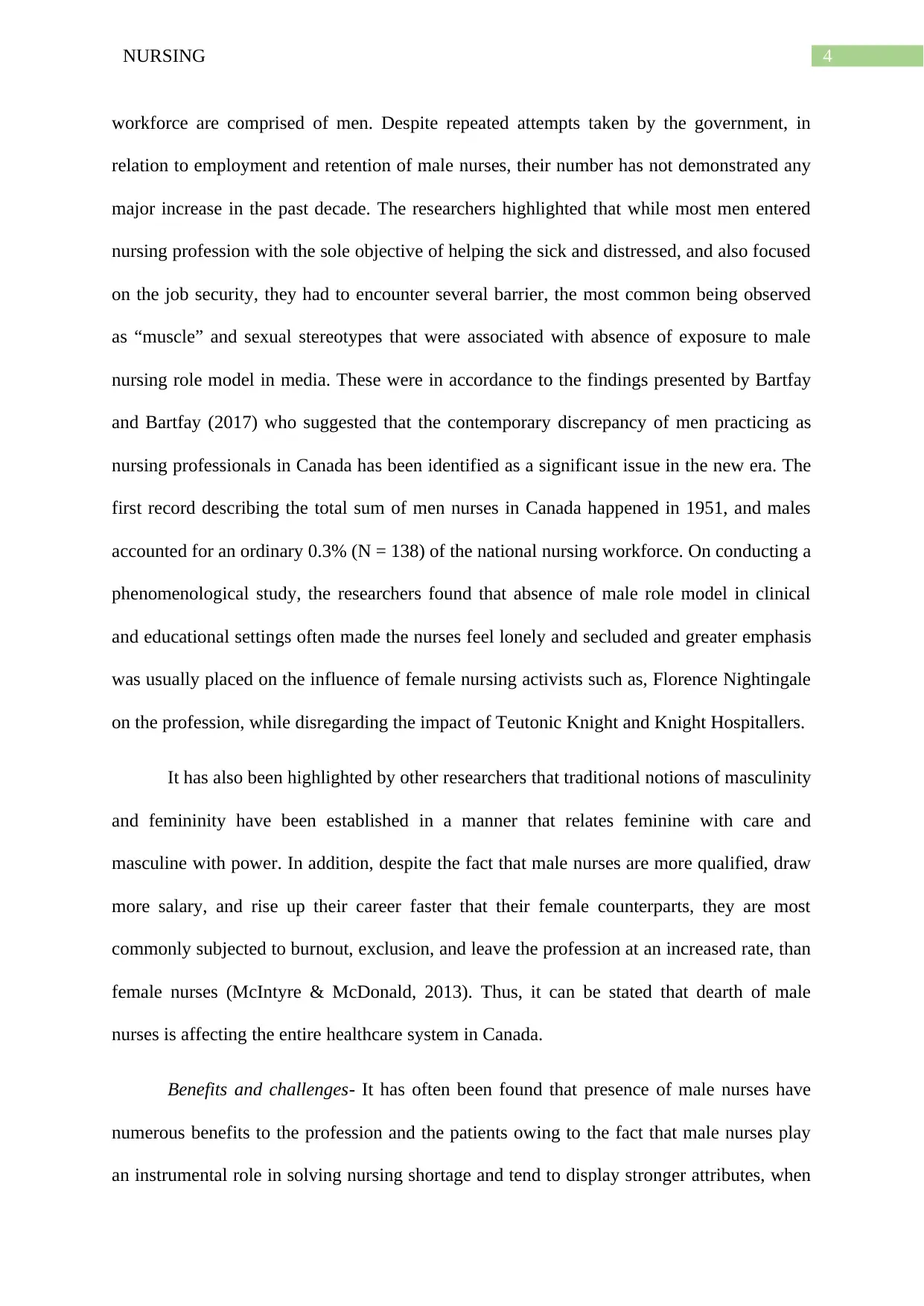
4NURSING
workforce are comprised of men. Despite repeated attempts taken by the government, in
relation to employment and retention of male nurses, their number has not demonstrated any
major increase in the past decade. The researchers highlighted that while most men entered
nursing profession with the sole objective of helping the sick and distressed, and also focused
on the job security, they had to encounter several barrier, the most common being observed
as “muscle” and sexual stereotypes that were associated with absence of exposure to male
nursing role model in media. These were in accordance to the findings presented by Bartfay
and Bartfay (2017) who suggested that the contemporary discrepancy of men practicing as
nursing professionals in Canada has been identified as a significant issue in the new era. The
first record describing the total sum of men nurses in Canada happened in 1951, and males
accounted for an ordinary 0.3% (N = 138) of the national nursing workforce. On conducting a
phenomenological study, the researchers found that absence of male role model in clinical
and educational settings often made the nurses feel lonely and secluded and greater emphasis
was usually placed on the influence of female nursing activists such as, Florence Nightingale
on the profession, while disregarding the impact of Teutonic Knight and Knight Hospitallers.
It has also been highlighted by other researchers that traditional notions of masculinity
and femininity have been established in a manner that relates feminine with care and
masculine with power. In addition, despite the fact that male nurses are more qualified, draw
more salary, and rise up their career faster that their female counterparts, they are most
commonly subjected to burnout, exclusion, and leave the profession at an increased rate, than
female nurses (McIntyre & McDonald, 2013). Thus, it can be stated that dearth of male
nurses is affecting the entire healthcare system in Canada.
Benefits and challenges- It has often been found that presence of male nurses have
numerous benefits to the profession and the patients owing to the fact that male nurses play
an instrumental role in solving nursing shortage and tend to display stronger attributes, when
workforce are comprised of men. Despite repeated attempts taken by the government, in
relation to employment and retention of male nurses, their number has not demonstrated any
major increase in the past decade. The researchers highlighted that while most men entered
nursing profession with the sole objective of helping the sick and distressed, and also focused
on the job security, they had to encounter several barrier, the most common being observed
as “muscle” and sexual stereotypes that were associated with absence of exposure to male
nursing role model in media. These were in accordance to the findings presented by Bartfay
and Bartfay (2017) who suggested that the contemporary discrepancy of men practicing as
nursing professionals in Canada has been identified as a significant issue in the new era. The
first record describing the total sum of men nurses in Canada happened in 1951, and males
accounted for an ordinary 0.3% (N = 138) of the national nursing workforce. On conducting a
phenomenological study, the researchers found that absence of male role model in clinical
and educational settings often made the nurses feel lonely and secluded and greater emphasis
was usually placed on the influence of female nursing activists such as, Florence Nightingale
on the profession, while disregarding the impact of Teutonic Knight and Knight Hospitallers.
It has also been highlighted by other researchers that traditional notions of masculinity
and femininity have been established in a manner that relates feminine with care and
masculine with power. In addition, despite the fact that male nurses are more qualified, draw
more salary, and rise up their career faster that their female counterparts, they are most
commonly subjected to burnout, exclusion, and leave the profession at an increased rate, than
female nurses (McIntyre & McDonald, 2013). Thus, it can be stated that dearth of male
nurses is affecting the entire healthcare system in Canada.
Benefits and challenges- It has often been found that presence of male nurses have
numerous benefits to the profession and the patients owing to the fact that male nurses play
an instrumental role in solving nursing shortage and tend to display stronger attributes, when
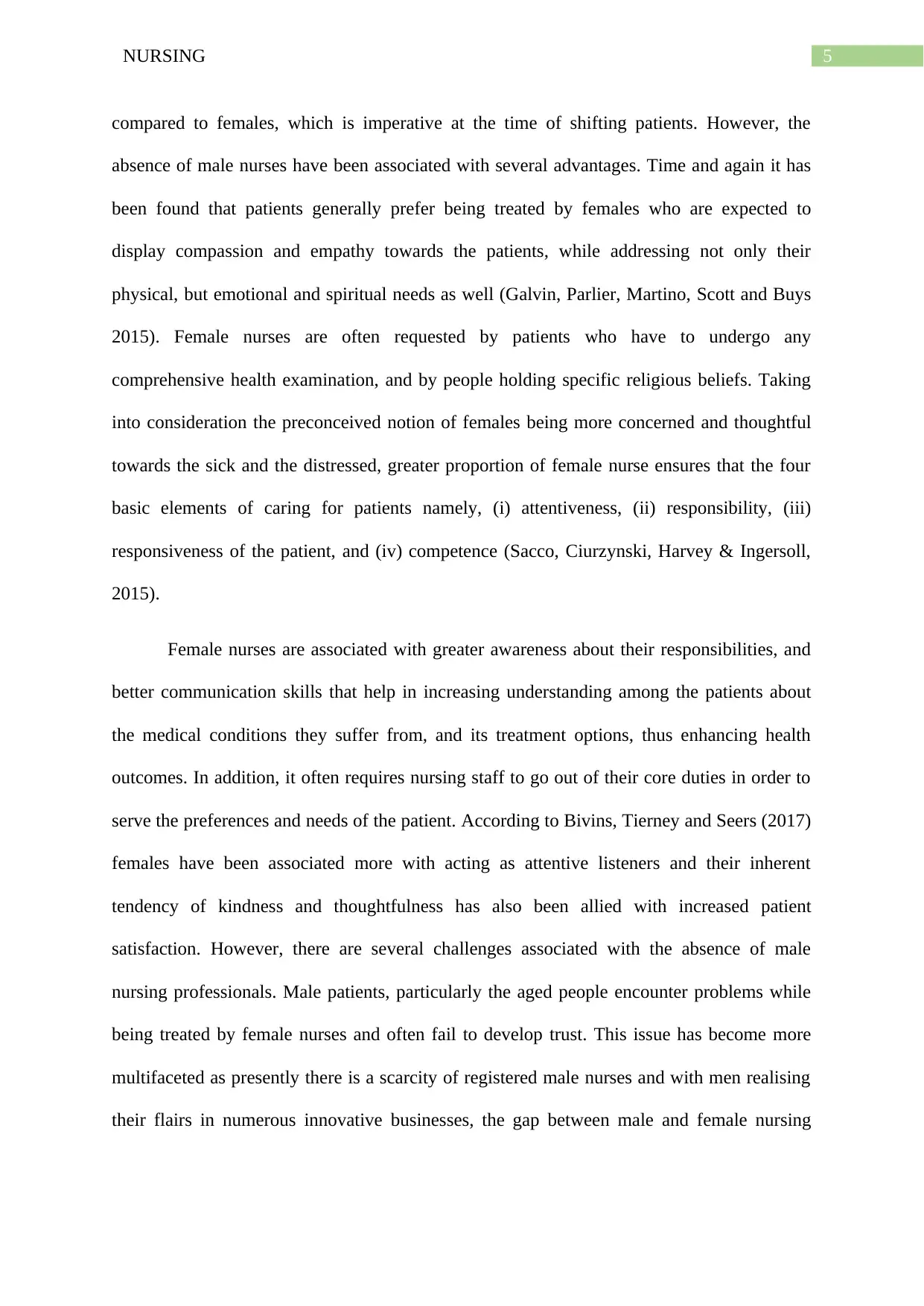
5NURSING
compared to females, which is imperative at the time of shifting patients. However, the
absence of male nurses have been associated with several advantages. Time and again it has
been found that patients generally prefer being treated by females who are expected to
display compassion and empathy towards the patients, while addressing not only their
physical, but emotional and spiritual needs as well (Galvin, Parlier, Martino, Scott and Buys
2015). Female nurses are often requested by patients who have to undergo any
comprehensive health examination, and by people holding specific religious beliefs. Taking
into consideration the preconceived notion of females being more concerned and thoughtful
towards the sick and the distressed, greater proportion of female nurse ensures that the four
basic elements of caring for patients namely, (i) attentiveness, (ii) responsibility, (iii)
responsiveness of the patient, and (iv) competence (Sacco, Ciurzynski, Harvey & Ingersoll,
2015).
Female nurses are associated with greater awareness about their responsibilities, and
better communication skills that help in increasing understanding among the patients about
the medical conditions they suffer from, and its treatment options, thus enhancing health
outcomes. In addition, it often requires nursing staff to go out of their core duties in order to
serve the preferences and needs of the patient. According to Bivins, Tierney and Seers (2017)
females have been associated more with acting as attentive listeners and their inherent
tendency of kindness and thoughtfulness has also been allied with increased patient
satisfaction. However, there are several challenges associated with the absence of male
nursing professionals. Male patients, particularly the aged people encounter problems while
being treated by female nurses and often fail to develop trust. This issue has become more
multifaceted as presently there is a scarcity of registered male nurses and with men realising
their flairs in numerous innovative businesses, the gap between male and female nursing
compared to females, which is imperative at the time of shifting patients. However, the
absence of male nurses have been associated with several advantages. Time and again it has
been found that patients generally prefer being treated by females who are expected to
display compassion and empathy towards the patients, while addressing not only their
physical, but emotional and spiritual needs as well (Galvin, Parlier, Martino, Scott and Buys
2015). Female nurses are often requested by patients who have to undergo any
comprehensive health examination, and by people holding specific religious beliefs. Taking
into consideration the preconceived notion of females being more concerned and thoughtful
towards the sick and the distressed, greater proportion of female nurse ensures that the four
basic elements of caring for patients namely, (i) attentiveness, (ii) responsibility, (iii)
responsiveness of the patient, and (iv) competence (Sacco, Ciurzynski, Harvey & Ingersoll,
2015).
Female nurses are associated with greater awareness about their responsibilities, and
better communication skills that help in increasing understanding among the patients about
the medical conditions they suffer from, and its treatment options, thus enhancing health
outcomes. In addition, it often requires nursing staff to go out of their core duties in order to
serve the preferences and needs of the patient. According to Bivins, Tierney and Seers (2017)
females have been associated more with acting as attentive listeners and their inherent
tendency of kindness and thoughtfulness has also been allied with increased patient
satisfaction. However, there are several challenges associated with the absence of male
nursing professionals. Male patients, particularly the aged people encounter problems while
being treated by female nurses and often fail to develop trust. This issue has become more
multifaceted as presently there is a scarcity of registered male nurses and with men realising
their flairs in numerous innovative businesses, the gap between male and female nursing
⊘ This is a preview!⊘
Do you want full access?
Subscribe today to unlock all pages.

Trusted by 1+ million students worldwide

6NURSING
workforce is becoming wider (Whiteside & Butcher, 2015). Hence, in order to close this gap,
the nursing association should focus more on recruiting male nursing students.
If male aged patients endure to insist upon obtaining care from male nurses, this
shortage will prove destructive to the medical industry. Although male nurses are considered
less compassionate, a dearth in male workforce suggests that the female nursing workforce is
aging and most of them will reach their retirement age, within the next decade. Hence,
absence of male nurses would lead to a greater workload and lack of adequate professionals
who would be able to deliver high quality care services, thus increasing the risk of poor
patient outcomes. With employment and retaining male nurses being recognised as
significant strategies to compensate for the critical nursing shortage, obvious or understated
discrimination against males in nursing unfavourably affects employment and retention, and
consequently prejudices determinations to address male nursing shortage (Ashkenazi,
Livshiz-Riven, Romem & Grinstein-Cohen, 2017).
Burnout among male nurses due to the discrimination and stereotype that they are
subjected to, and the lack of male faculty or role model also results in significant physical and
emotional distress, thus desensitizing the men and making them display lack of empathy
towards the patients. This in turn results in disruption of an effective nurse-patient therapeutic
relationship and also deteriorates the health-realted quality of life of the care receivers (Ang
et al., 2016). Lack of adequate nursing staff also increase the odds of adverse health events
among patients, thus imposing greater risks to patient health and safety. Thus, shortage of
male nurses are creating significant impact on patient care.
Impact and implications- Time and again it has been established that nursing is amid
one of the fastest evolving occupations in recent times and the healthcare system of Canada
cannot work without an adequate nursing workforce (Cherry & Jacob, 2016). In addition, the
workforce is becoming wider (Whiteside & Butcher, 2015). Hence, in order to close this gap,
the nursing association should focus more on recruiting male nursing students.
If male aged patients endure to insist upon obtaining care from male nurses, this
shortage will prove destructive to the medical industry. Although male nurses are considered
less compassionate, a dearth in male workforce suggests that the female nursing workforce is
aging and most of them will reach their retirement age, within the next decade. Hence,
absence of male nurses would lead to a greater workload and lack of adequate professionals
who would be able to deliver high quality care services, thus increasing the risk of poor
patient outcomes. With employment and retaining male nurses being recognised as
significant strategies to compensate for the critical nursing shortage, obvious or understated
discrimination against males in nursing unfavourably affects employment and retention, and
consequently prejudices determinations to address male nursing shortage (Ashkenazi,
Livshiz-Riven, Romem & Grinstein-Cohen, 2017).
Burnout among male nurses due to the discrimination and stereotype that they are
subjected to, and the lack of male faculty or role model also results in significant physical and
emotional distress, thus desensitizing the men and making them display lack of empathy
towards the patients. This in turn results in disruption of an effective nurse-patient therapeutic
relationship and also deteriorates the health-realted quality of life of the care receivers (Ang
et al., 2016). Lack of adequate nursing staff also increase the odds of adverse health events
among patients, thus imposing greater risks to patient health and safety. Thus, shortage of
male nurses are creating significant impact on patient care.
Impact and implications- Time and again it has been established that nursing is amid
one of the fastest evolving occupations in recent times and the healthcare system of Canada
cannot work without an adequate nursing workforce (Cherry & Jacob, 2016). In addition, the
Paraphrase This Document
Need a fresh take? Get an instant paraphrase of this document with our AI Paraphraser
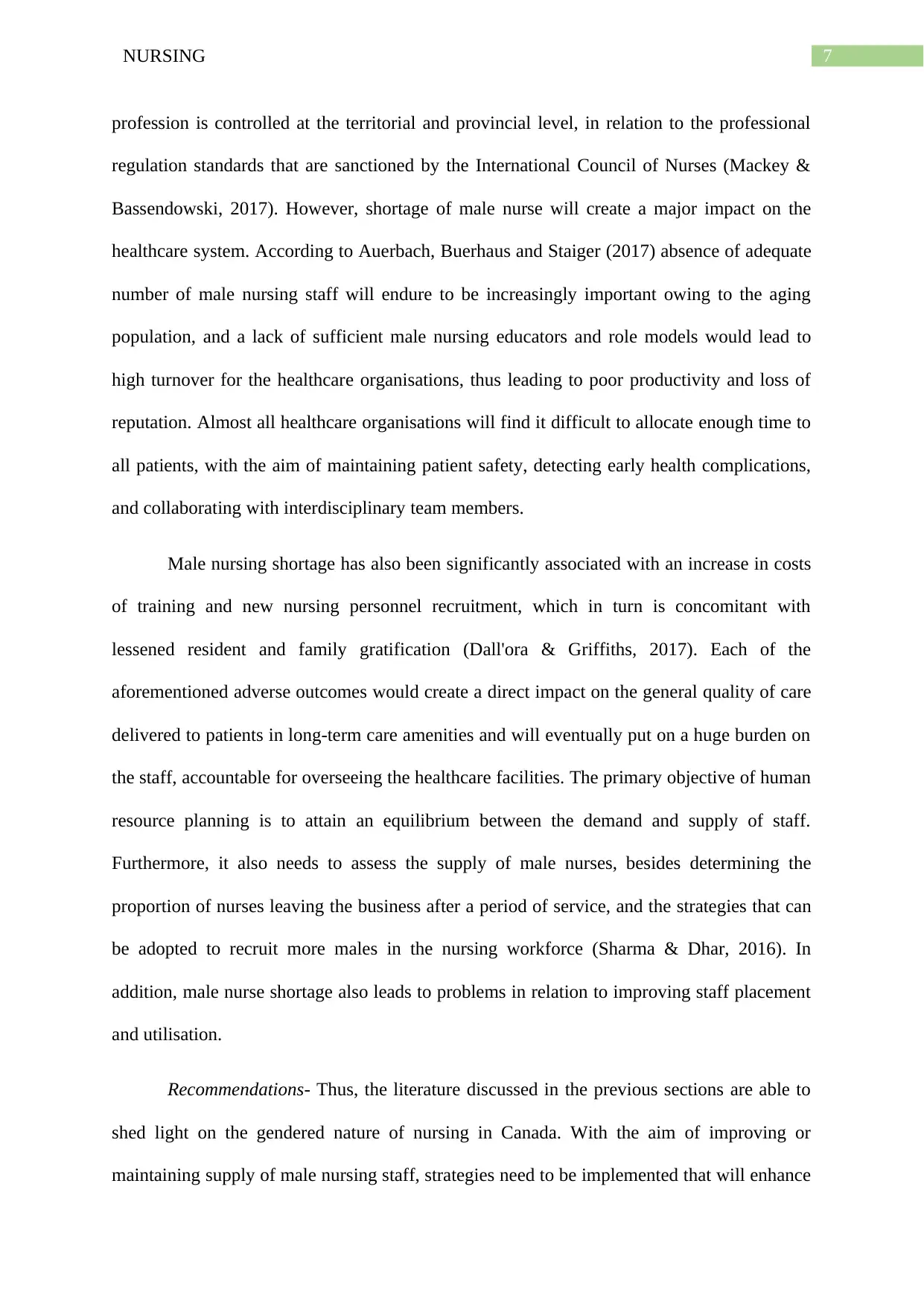
7NURSING
profession is controlled at the territorial and provincial level, in relation to the professional
regulation standards that are sanctioned by the International Council of Nurses (Mackey &
Bassendowski, 2017). However, shortage of male nurse will create a major impact on the
healthcare system. According to Auerbach, Buerhaus and Staiger (2017) absence of adequate
number of male nursing staff will endure to be increasingly important owing to the aging
population, and a lack of sufficient male nursing educators and role models would lead to
high turnover for the healthcare organisations, thus leading to poor productivity and loss of
reputation. Almost all healthcare organisations will find it difficult to allocate enough time to
all patients, with the aim of maintaining patient safety, detecting early health complications,
and collaborating with interdisciplinary team members.
Male nursing shortage has also been significantly associated with an increase in costs
of training and new nursing personnel recruitment, which in turn is concomitant with
lessened resident and family gratification (Dall'ora & Griffiths, 2017). Each of the
aforementioned adverse outcomes would create a direct impact on the general quality of care
delivered to patients in long-term care amenities and will eventually put on a huge burden on
the staff, accountable for overseeing the healthcare facilities. The primary objective of human
resource planning is to attain an equilibrium between the demand and supply of staff.
Furthermore, it also needs to assess the supply of male nurses, besides determining the
proportion of nurses leaving the business after a period of service, and the strategies that can
be adopted to recruit more males in the nursing workforce (Sharma & Dhar, 2016). In
addition, male nurse shortage also leads to problems in relation to improving staff placement
and utilisation.
Recommendations- Thus, the literature discussed in the previous sections are able to
shed light on the gendered nature of nursing in Canada. With the aim of improving or
maintaining supply of male nursing staff, strategies need to be implemented that will enhance
profession is controlled at the territorial and provincial level, in relation to the professional
regulation standards that are sanctioned by the International Council of Nurses (Mackey &
Bassendowski, 2017). However, shortage of male nurse will create a major impact on the
healthcare system. According to Auerbach, Buerhaus and Staiger (2017) absence of adequate
number of male nursing staff will endure to be increasingly important owing to the aging
population, and a lack of sufficient male nursing educators and role models would lead to
high turnover for the healthcare organisations, thus leading to poor productivity and loss of
reputation. Almost all healthcare organisations will find it difficult to allocate enough time to
all patients, with the aim of maintaining patient safety, detecting early health complications,
and collaborating with interdisciplinary team members.
Male nursing shortage has also been significantly associated with an increase in costs
of training and new nursing personnel recruitment, which in turn is concomitant with
lessened resident and family gratification (Dall'ora & Griffiths, 2017). Each of the
aforementioned adverse outcomes would create a direct impact on the general quality of care
delivered to patients in long-term care amenities and will eventually put on a huge burden on
the staff, accountable for overseeing the healthcare facilities. The primary objective of human
resource planning is to attain an equilibrium between the demand and supply of staff.
Furthermore, it also needs to assess the supply of male nurses, besides determining the
proportion of nurses leaving the business after a period of service, and the strategies that can
be adopted to recruit more males in the nursing workforce (Sharma & Dhar, 2016). In
addition, male nurse shortage also leads to problems in relation to improving staff placement
and utilisation.
Recommendations- Thus, the literature discussed in the previous sections are able to
shed light on the gendered nature of nursing in Canada. With the aim of improving or
maintaining supply of male nursing staff, strategies need to be implemented that will enhance

8NURSING
the image of nursing service amongst potential male recruits and will promote the profession
among them. It is necessary to increase the number of male faculty members who will
provide training and education to nursing students during the graduation, in order to reduce
isolation and segregation. Retention of male nurses can also be increased by ensuring that the
pay rates are viable, particularly in a nation like Canada where nursing has often been
underrated as “women’s work” (Shantz, Alfes & Arevshatian, 2016). In order to recruit an
increased number of males in the profession, it is suggested that advantages of job security,
career opportunities and salary must be integrated into nursing professional’s career fairs,
employing advertisements, and publicity material intended to create an impact on the
decision among males to enter nursing profession. Emphasis must be placed on the rewarding
nature of the job, and equivalence of a caring disposition with the discernments of being a
male nurse (Sawatzky, Enns & Legare, 2015).
There is a necessity within the domains of nursing education and practice for
increasing awareness on the fact that male nurses are not only recruited based on their
strength, besides taking necessary efforts for preventing the manifestation of gender
discrimination. The major challenge for nursing programs is to help recruitment efforts by
increasing visibility of male nurses and endorse advertisements/promotional materials that
depict nurses in manners that validate knowledge, competency, and technical expertise,
regardless of the gender of the care professionals (Mooring, 2016).
Conclusion- Nursing in the 21st century is based on the social contract that delineates
the responsibilities and professional rights, in addition to different mechanism for public
liability. Furthermore, the nurses also work tirelessly for the identification and protection of
the preferences and needs of the patient. Males who select nursing are usually not satisfied
and report hesitation in acclaiming the profession to others. Several countries, particularly
Canada are suffering difficulties with critical scarcity of male nurses, and it is vital that
the image of nursing service amongst potential male recruits and will promote the profession
among them. It is necessary to increase the number of male faculty members who will
provide training and education to nursing students during the graduation, in order to reduce
isolation and segregation. Retention of male nurses can also be increased by ensuring that the
pay rates are viable, particularly in a nation like Canada where nursing has often been
underrated as “women’s work” (Shantz, Alfes & Arevshatian, 2016). In order to recruit an
increased number of males in the profession, it is suggested that advantages of job security,
career opportunities and salary must be integrated into nursing professional’s career fairs,
employing advertisements, and publicity material intended to create an impact on the
decision among males to enter nursing profession. Emphasis must be placed on the rewarding
nature of the job, and equivalence of a caring disposition with the discernments of being a
male nurse (Sawatzky, Enns & Legare, 2015).
There is a necessity within the domains of nursing education and practice for
increasing awareness on the fact that male nurses are not only recruited based on their
strength, besides taking necessary efforts for preventing the manifestation of gender
discrimination. The major challenge for nursing programs is to help recruitment efforts by
increasing visibility of male nurses and endorse advertisements/promotional materials that
depict nurses in manners that validate knowledge, competency, and technical expertise,
regardless of the gender of the care professionals (Mooring, 2016).
Conclusion- Nursing in the 21st century is based on the social contract that delineates
the responsibilities and professional rights, in addition to different mechanism for public
liability. Furthermore, the nurses also work tirelessly for the identification and protection of
the preferences and needs of the patient. Males who select nursing are usually not satisfied
and report hesitation in acclaiming the profession to others. Several countries, particularly
Canada are suffering difficulties with critical scarcity of male nurses, and it is vital that
⊘ This is a preview!⊘
Do you want full access?
Subscribe today to unlock all pages.

Trusted by 1+ million students worldwide
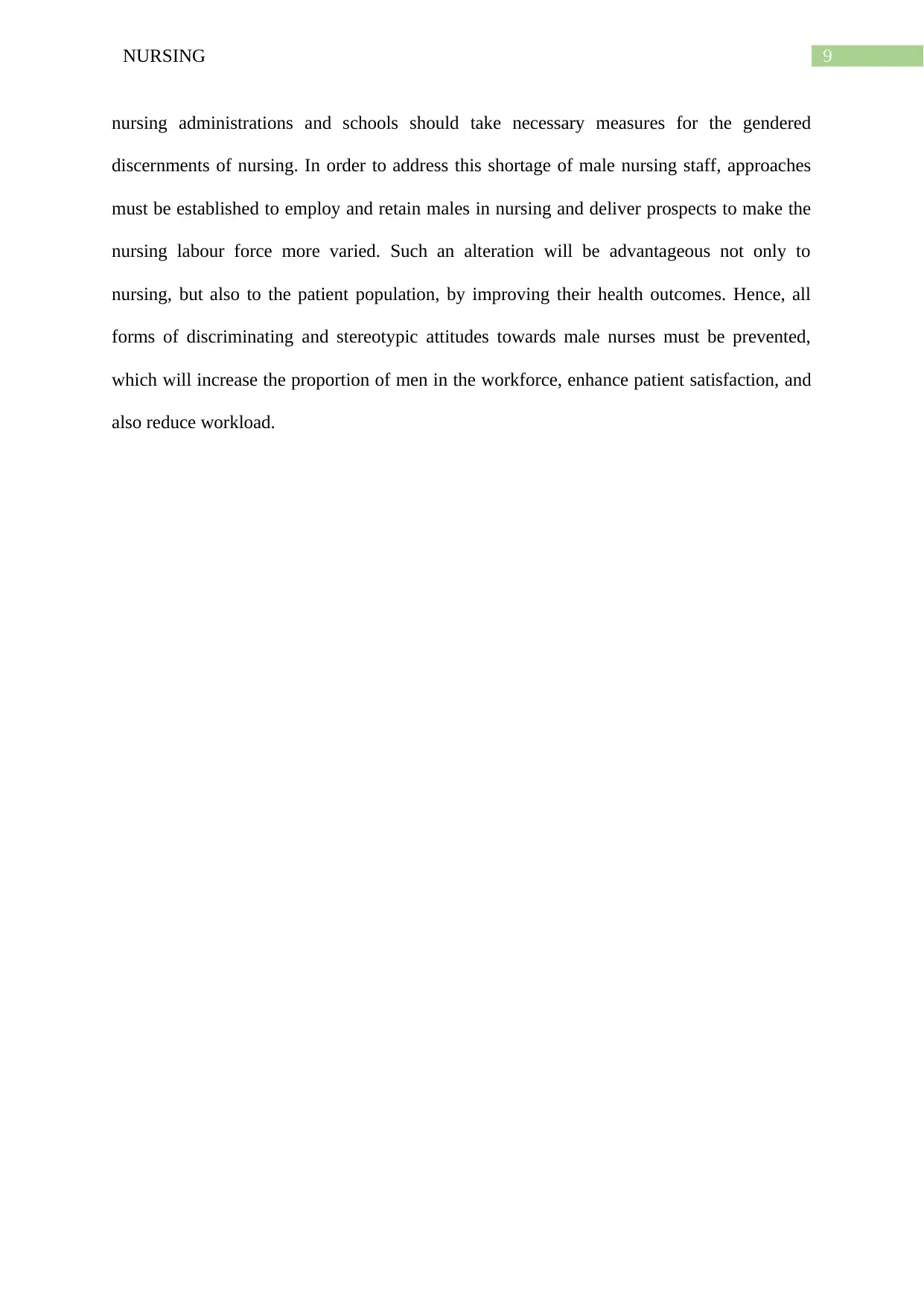
9NURSING
nursing administrations and schools should take necessary measures for the gendered
discernments of nursing. In order to address this shortage of male nursing staff, approaches
must be established to employ and retain males in nursing and deliver prospects to make the
nursing labour force more varied. Such an alteration will be advantageous not only to
nursing, but also to the patient population, by improving their health outcomes. Hence, all
forms of discriminating and stereotypic attitudes towards male nurses must be prevented,
which will increase the proportion of men in the workforce, enhance patient satisfaction, and
also reduce workload.
nursing administrations and schools should take necessary measures for the gendered
discernments of nursing. In order to address this shortage of male nursing staff, approaches
must be established to employ and retain males in nursing and deliver prospects to make the
nursing labour force more varied. Such an alteration will be advantageous not only to
nursing, but also to the patient population, by improving their health outcomes. Hence, all
forms of discriminating and stereotypic attitudes towards male nurses must be prevented,
which will increase the proportion of men in the workforce, enhance patient satisfaction, and
also reduce workload.
Paraphrase This Document
Need a fresh take? Get an instant paraphrase of this document with our AI Paraphraser
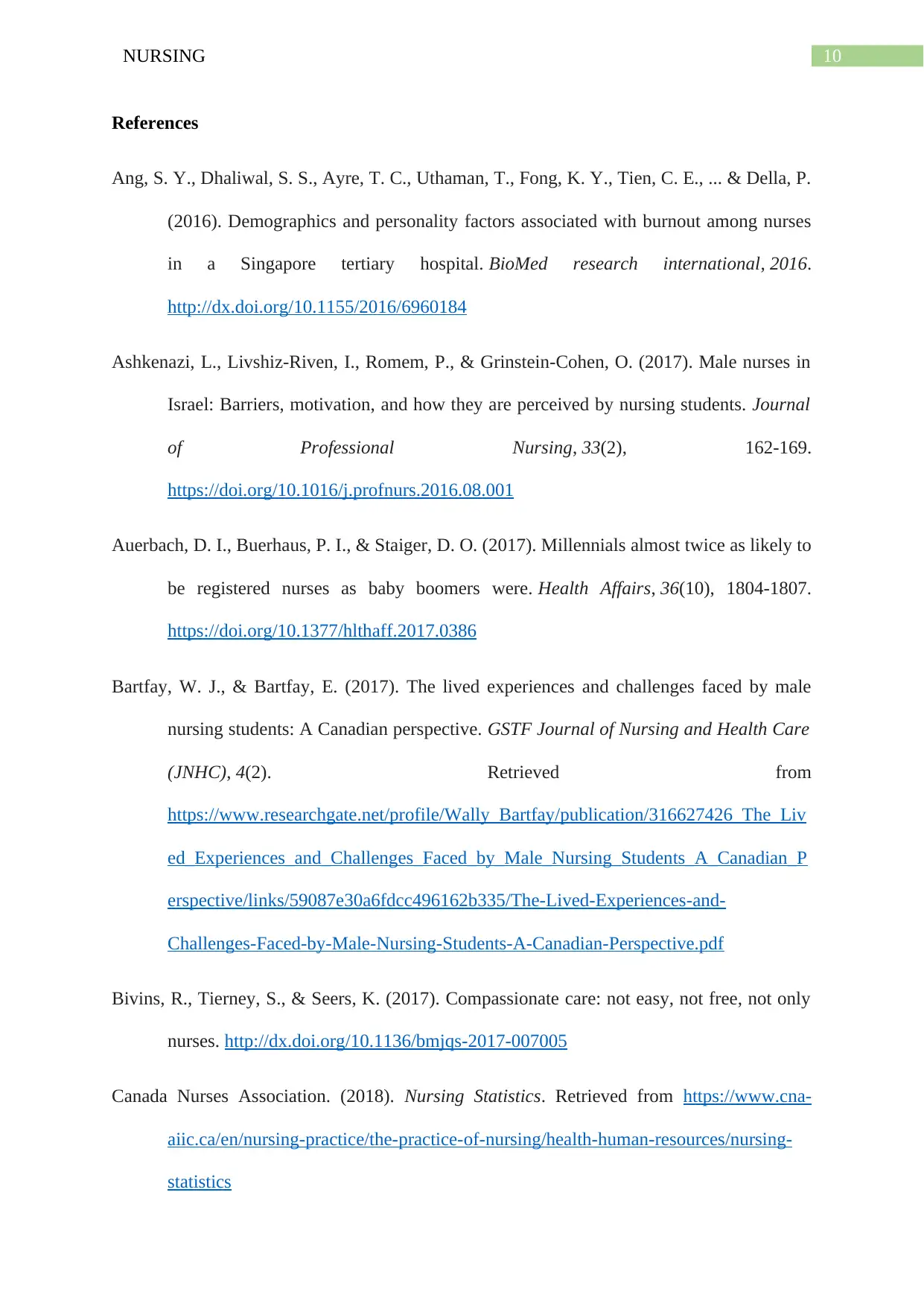
10NURSING
References
Ang, S. Y., Dhaliwal, S. S., Ayre, T. C., Uthaman, T., Fong, K. Y., Tien, C. E., ... & Della, P.
(2016). Demographics and personality factors associated with burnout among nurses
in a Singapore tertiary hospital. BioMed research international, 2016.
http://dx.doi.org/10.1155/2016/6960184
Ashkenazi, L., Livshiz-Riven, I., Romem, P., & Grinstein-Cohen, O. (2017). Male nurses in
Israel: Barriers, motivation, and how they are perceived by nursing students. Journal
of Professional Nursing, 33(2), 162-169.
https://doi.org/10.1016/j.profnurs.2016.08.001
Auerbach, D. I., Buerhaus, P. I., & Staiger, D. O. (2017). Millennials almost twice as likely to
be registered nurses as baby boomers were. Health Affairs, 36(10), 1804-1807.
https://doi.org/10.1377/hlthaff.2017.0386
Bartfay, W. J., & Bartfay, E. (2017). The lived experiences and challenges faced by male
nursing students: A Canadian perspective. GSTF Journal of Nursing and Health Care
(JNHC), 4(2). Retrieved from
https://www.researchgate.net/profile/Wally_Bartfay/publication/316627426_The_Liv
ed_Experiences_and_Challenges_Faced_by_Male_Nursing_Students_A_Canadian_P
erspective/links/59087e30a6fdcc496162b335/The-Lived-Experiences-and-
Challenges-Faced-by-Male-Nursing-Students-A-Canadian-Perspective.pdf
Bivins, R., Tierney, S., & Seers, K. (2017). Compassionate care: not easy, not free, not only
nurses. http://dx.doi.org/10.1136/bmjqs-2017-007005
Canada Nurses Association. (2018). Nursing Statistics. Retrieved from https://www.cna-
aiic.ca/en/nursing-practice/the-practice-of-nursing/health-human-resources/nursing-
statistics
References
Ang, S. Y., Dhaliwal, S. S., Ayre, T. C., Uthaman, T., Fong, K. Y., Tien, C. E., ... & Della, P.
(2016). Demographics and personality factors associated with burnout among nurses
in a Singapore tertiary hospital. BioMed research international, 2016.
http://dx.doi.org/10.1155/2016/6960184
Ashkenazi, L., Livshiz-Riven, I., Romem, P., & Grinstein-Cohen, O. (2017). Male nurses in
Israel: Barriers, motivation, and how they are perceived by nursing students. Journal
of Professional Nursing, 33(2), 162-169.
https://doi.org/10.1016/j.profnurs.2016.08.001
Auerbach, D. I., Buerhaus, P. I., & Staiger, D. O. (2017). Millennials almost twice as likely to
be registered nurses as baby boomers were. Health Affairs, 36(10), 1804-1807.
https://doi.org/10.1377/hlthaff.2017.0386
Bartfay, W. J., & Bartfay, E. (2017). The lived experiences and challenges faced by male
nursing students: A Canadian perspective. GSTF Journal of Nursing and Health Care
(JNHC), 4(2). Retrieved from
https://www.researchgate.net/profile/Wally_Bartfay/publication/316627426_The_Liv
ed_Experiences_and_Challenges_Faced_by_Male_Nursing_Students_A_Canadian_P
erspective/links/59087e30a6fdcc496162b335/The-Lived-Experiences-and-
Challenges-Faced-by-Male-Nursing-Students-A-Canadian-Perspective.pdf
Bivins, R., Tierney, S., & Seers, K. (2017). Compassionate care: not easy, not free, not only
nurses. http://dx.doi.org/10.1136/bmjqs-2017-007005
Canada Nurses Association. (2018). Nursing Statistics. Retrieved from https://www.cna-
aiic.ca/en/nursing-practice/the-practice-of-nursing/health-human-resources/nursing-
statistics

11NURSING
Carrigan, T. M., & Brooks, B. A. (2016). Q: How will we achieve 20% by 2020? A: Men in
nursing. Nurse Leader, 14(2), 115-119. https://doi.org/10.1016/j.mnl.2015.12.012
Cherry, B., & Jacob, S. R. (2016). Contemporary nursing: Issues, trends, & management.
Elsevier Health Sciences. Retrieved from https://books.google.co.in/books?
hl=en&lr=&id=vzzdCwAAQBAJ&oi=fnd&pg=PP1&dq=nursing+AND+evolving+w
orkforce&ots=mNvi4hCukv&sig=gEd4Sri4nMFjig8PS1UgeWD9hdw#v=onepage&q
=nursing%20AND%20evolving%20workforce&f=false
Christensen, M. (2016). Men in nursing: The early years. Journal of Nursing Education &
Practice, 7(5), 94-103. DOI: 10.5430/jnep.v7n5p94
Dall'ora, C., & Griffiths, P. (2017). Flexible nurse staffing in hospital wards: the effects on
costs and patient outcomes. Health Work: Evidence Briefs, 3(1). Retrieved from
https://eprints.soton.ac.uk/id/eprint/412514
Galvin, S. L., Parlier, A. B., Martino, E., Scott, K. R., & Buys, E. (2015). Gender bias in
nurse evaluations of residents in obstetrics and gynecology. Obstetrics &
Gynecology, 126, 7S-12S. doi: 10.1097/AOG.0000000000001044
Henly, S. J., McCarthy, D. O., Wyman, J. F., Alt-White, A. C., Stone, P. W., McCarthy, A.
M., ... & Heitkemper, M. M. (2015). Emerging areas of nursing science and PhD
education for the 21st century: Response to commentaries. Nursing outlook, 63(4),
439-445. https://doi.org/10.1016/j.outlook.2015.05.003
Hollup, O. (2014). The impact of gender, culture, and sexuality on Mauritian nursing:
Nursing as a non-gendered occupational identity or masculine field? Qualitative
study. International journal of nursing studies, 51(5), 752-760.
https://doi.org/10.1016/j.ijnurstu.2013.09.013
Carrigan, T. M., & Brooks, B. A. (2016). Q: How will we achieve 20% by 2020? A: Men in
nursing. Nurse Leader, 14(2), 115-119. https://doi.org/10.1016/j.mnl.2015.12.012
Cherry, B., & Jacob, S. R. (2016). Contemporary nursing: Issues, trends, & management.
Elsevier Health Sciences. Retrieved from https://books.google.co.in/books?
hl=en&lr=&id=vzzdCwAAQBAJ&oi=fnd&pg=PP1&dq=nursing+AND+evolving+w
orkforce&ots=mNvi4hCukv&sig=gEd4Sri4nMFjig8PS1UgeWD9hdw#v=onepage&q
=nursing%20AND%20evolving%20workforce&f=false
Christensen, M. (2016). Men in nursing: The early years. Journal of Nursing Education &
Practice, 7(5), 94-103. DOI: 10.5430/jnep.v7n5p94
Dall'ora, C., & Griffiths, P. (2017). Flexible nurse staffing in hospital wards: the effects on
costs and patient outcomes. Health Work: Evidence Briefs, 3(1). Retrieved from
https://eprints.soton.ac.uk/id/eprint/412514
Galvin, S. L., Parlier, A. B., Martino, E., Scott, K. R., & Buys, E. (2015). Gender bias in
nurse evaluations of residents in obstetrics and gynecology. Obstetrics &
Gynecology, 126, 7S-12S. doi: 10.1097/AOG.0000000000001044
Henly, S. J., McCarthy, D. O., Wyman, J. F., Alt-White, A. C., Stone, P. W., McCarthy, A.
M., ... & Heitkemper, M. M. (2015). Emerging areas of nursing science and PhD
education for the 21st century: Response to commentaries. Nursing outlook, 63(4),
439-445. https://doi.org/10.1016/j.outlook.2015.05.003
Hollup, O. (2014). The impact of gender, culture, and sexuality on Mauritian nursing:
Nursing as a non-gendered occupational identity or masculine field? Qualitative
study. International journal of nursing studies, 51(5), 752-760.
https://doi.org/10.1016/j.ijnurstu.2013.09.013
⊘ This is a preview!⊘
Do you want full access?
Subscribe today to unlock all pages.

Trusted by 1+ million students worldwide
1 out of 15
Related Documents
Your All-in-One AI-Powered Toolkit for Academic Success.
+13062052269
info@desklib.com
Available 24*7 on WhatsApp / Email
![[object Object]](/_next/static/media/star-bottom.7253800d.svg)
Unlock your academic potential
Copyright © 2020–2025 A2Z Services. All Rights Reserved. Developed and managed by ZUCOL.





